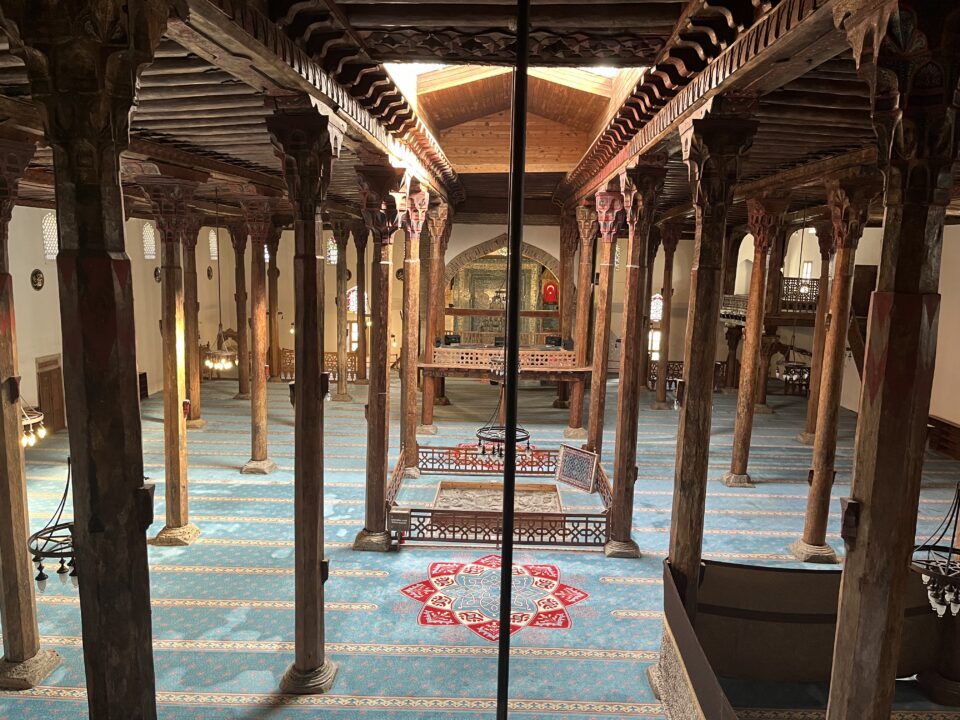Home to ancient civilisations throughout history, the Anatolian lands house historical and architectural discoveries that offer unique experiences for the visitors of the present. These treasures include “Anatolia’s Medieval Wooden Hypostyle Mosques” – Türkiye’s twenty-first item on the UNESCO World Heritage list, added last year. The route features architectural structures from the Turkish-Islamic tradition, including five mosques erected in Anatolia between the late 13th and mid-14th centuries, the first of which were built by the Turks. These intriguing mosques date from the Middle Ages and share technical characteristics such as wooden interior columns (hypostyle type) and decorations reflecting the aesthetic understanding of the era. Let’s discover more about these magnificent structures in five different Anatolian cities and other noteworthy local landmarks.
Konya: Beyşehir Eşrefoğlu Mosque
The route starts at the Beyşehir Eşrefoğlu Mosque in Konya. In the 12th and 13th centuries, Konya was the capital for the Seljuk Turks, and many artefacts from that time can still be seen in the city. The Beyşehir Eşrefoğlu Mosque, erected between 1296-1299, is one of them. Showcasing the splendour of Seljuk-period stone and woodwork, Anatolia’s largest wooden mosque is the only one that incorporates multiple decorative arts, including stone, brick, and colourful tilework.
Must See: Visit Çatalhöyük, one of Türkiye’s UNESCO World Heritage Sites and ranked among the world’s oldest Neolithic settlements. The newly opened Çatalhöyük Information and Visitor Centre allows visitors to take an interactive journey through the history of the famous site.
Must Eat: Sample Konya’s famous etli ekmek, a flatbread topped with spiced minced meat.
Afyonkarahisar: Ulu (Grand) Mosque
The next destination is Konya’s neighbour, Afyonkarahisar. The Ulu (Grand) Mosque, one of the largest mosques in this historic city that has hosted civilisations from the Phrygians to the Ottoman Empire, was also erected by the Seljuks. The building, restored in our time while retaining its original form, is a superb example of Seljuk architecture and woodwork. The structure is also known as the “40 Pillar Mosque” because it features 40 wooden pillars set in five rows.
Must See: In Afyon, you can visit the Mountainous Phrygia region, where rock fragments and ancient ruins bearing the traces of the Phrygians are located. In 2015, the area was included in the UNESCO World Tentative Heritage List, offering insight into three thousand years of history.
Must Eat: In Afyonkarahisar, a member of the UNESCO Creative Cities Network in gastronomy, local specialities include Turkish delight, sucuk and kaymak.
Eskişehir: Sivrihisar Ulu (Grand) Mosque
Eskişehir is an impressive city with historical and modern facets. The Sivrihisar Ulu (Grand) Mosque in Eskişehir is one of the largest wooden-column mosques in Anatolia. In the mosque, which can accommodate up to 2,500 worshippers, one can see fine examples of Sivrihisar rug weaving. Some of the 67 pillars in the mosque feature pencil ornaments, while others have column capitals from the Eastern Roman period. The mosque is also famous for its minbar, which is made of walnut wood and is considered one of the most beautiful examples of its kind.
Must See: Yazılıkaya, in Eskişehir’s Han district, houses the Midas Monument, named after the legendary king Midas, who is said to have turned Gordion’s touch into gold. Surrounded by ancient caves and temples, it is worth a visit to view the magnificent 17-meter-high temple carved into rock approximately three thousand years earlier.
Must Eat: Eskişehir, historically known as the wheat warehouse of Anatolia, is also known for çibörek, traditionally made with minced meat.
Ankara: Ahi Şerafeddin (Arslanhane) Mosque
The Ahi Şerefeddin Mosque in Ankara, just a 1.5-hour high-speed train ride from Eskişehir, is an architectural marvel despite its simple appearance. The Seljuk-era structure is also known as Arslanhane (Lion House) for the ancient marble lion statue on the inside tomb wall. The single-storey mosque, featuring 24 wooden columns and marble capitals, exemplifies the harmony of spolia and wood.
Must See: You must visit Gordion, the City of King Midas and Türkiye’s 20th cultural heritage site on the UNESCO World Heritage List. Gordion and the area around the city are notable for hosting 4,500 years of nearly continuous settlement. Visit the five million-year-old Tulumtaş Cave in Ankara’s Gölbaşı district; the cave, which has accelerated its development over the last million years, is archaeologically significant because it contains settlement layers from the Middle Bronze Age, Hellenistic, Roman and Eastern Roman periods in its mounds.
Must Eat: While in Türkiye’s capital, sample Ankara simidi, döner and Çubuk turşusu (pickles).
Kastamonu: Kasaba Village Mahmut Bey Mosque
The Kasaba Village Mahmut Bey Mosque in Kastamonu is the last structure on the Anatolian wooden mosque route. The mosque, built during the Candaroğulları Principality, is renowned as the «Nailless Mosque» due to its unique overlapping structure without using metal nails. One of the building’s most outstanding characteristics is its beautiful crown gate, a piece of art. Because there are so few examples of its type in Türkiye, the door is housed in the Kastamonu Ethnography Museum. After visiting the mosque, head to the museum to see the door and learn more about Kastamonu culture.
Must See: You can visit the Kastamonu historical mansions, built in the late 19th and the first half of the 20th century, and the Archaeology Museum, which reveals the archaeological richness of the city.
Must Eat: Before leaving the city, make sure you try simit tiridi, which is made by crushed stale simits without sesame seeds and served with bone broth and garlic yoghurt.
www.gotürkiye.com

